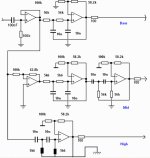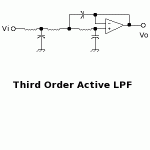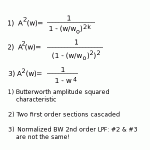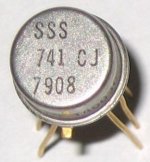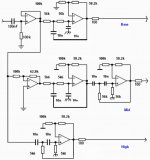A friend asked me, he wants to build...but he wants active!... the one is already knowing i am doing passive input filters to amplifiers.... i do not know how to make it active...i have just an idea about...can you help posting schematics?
Yes..i have a lot of good operational amplifiers if needed... but i would be more happy with discrete, because less stages means lower distortion (normally)
Bass - 1 hertz to 200 hertz (-3dB) to the bass power amplifier unit (sub)
Mids - 200 hertz (-3dB) to 4 kilohertz
treble - 4 kilohertz and up.
thank you in advance by your cooperation...i can discover how to do it..but will take a lot of time..having your suggestion will be easier.... and faster!
Input and output impedance around 47K
Gain of one, input 1 volt rms ...or something more modern and up to date you suggest.
Volume potentiometer included into the input of these three filter channels..or active pré amplifier if you want to call this way.
Help!
regards,
Carlos
Yes..i have a lot of good operational amplifiers if needed... but i would be more happy with discrete, because less stages means lower distortion (normally)
Bass - 1 hertz to 200 hertz (-3dB) to the bass power amplifier unit (sub)
Mids - 200 hertz (-3dB) to 4 kilohertz
treble - 4 kilohertz and up.
thank you in advance by your cooperation...i can discover how to do it..but will take a lot of time..having your suggestion will be easier.... and faster!
Input and output impedance around 47K
Gain of one, input 1 volt rms ...or something more modern and up to date you suggest.
Volume potentiometer included into the input of these three filter channels..or active pré amplifier if you want to call this way.
Help!
regards,
Carlos
Last edited:
Thank you Andrew T and Richie boy
To learn how to make it will spend a lot of time..and this is an issue..i had not too much free time time those last monthes.
You know....i have not the time to learn that..i have a dead line... this must be fast...i am searching for the stuff ready and tested..not to learn or develop.
Will take a good look at ESP pages..maybe the filters there are "ready to go"
regards,
Carlos
To learn how to make it will spend a lot of time..and this is an issue..i had not too much free time time those last monthes.
You know....i have not the time to learn that..i have a dead line... this must be fast...i am searching for the stuff ready and tested..not to learn or develop.
Will take a good look at ESP pages..maybe the filters there are "ready to go"
regards,
Carlos
Linkwitz has complete active crossover designs as well as generic theory pages
Active Filters
http://www.linkwitzlab.com/xo_eq.htm
http://www.linkwitzlab.com/crossovers.htm
Active Filters
http://www.linkwitzlab.com/xo_eq.htm
http://www.linkwitzlab.com/crossovers.htm
"Is this correct?... can you please observe if i made errors"
It looks like you have made a series of nopass filters in that schemo (dead shorts across the op-amps).
There is more to designing a filter than just connecting resistors to capacitors. What characteristics are you looking for? The Chebychev characteristic gives the best skirt selectivity at the expense of amplitude response and phase linearity. The Bessel characteristic has the best phase linearity, the poorest skirt selectivity, and a fair amplitude response. The Butterworth -- a good compromise between skirt selectivity, amplitude response (the best) and a well behaved phase characteristic, except it goes a bit wonky near its cutoff frequency.
Here's what an active LPF ought to look like. The HPF simply interchanges the resistors and capacitors. (Attached). I'd always make the odd ordered filters, since it just costs you one additional resistor and capacitor. An extra -3.0db of roll off/on for cheap.
It looks like you have made a series of nopass filters in that schemo (dead shorts across the op-amps).
There is more to designing a filter than just connecting resistors to capacitors. What characteristics are you looking for? The Chebychev characteristic gives the best skirt selectivity at the expense of amplitude response and phase linearity. The Bessel characteristic has the best phase linearity, the poorest skirt selectivity, and a fair amplitude response. The Butterworth -- a good compromise between skirt selectivity, amplitude response (the best) and a well behaved phase characteristic, except it goes a bit wonky near its cutoff frequency.
Here's what an active LPF ought to look like. The HPF simply interchanges the resistors and capacitors. (Attached). I'd always make the odd ordered filters, since it just costs you one additional resistor and capacitor. An extra -3.0db of roll off/on for cheap.
Attachments
Here is another theory page:
Body
And if you are building the amp from scratch for dedicated use one could sandwich PLLXOs between stages:
Passive High-Level Crossover
dave
Body
And if you are building the amp from scratch for dedicated use one could sandwich PLLXOs between stages:
Passive High-Level Crossover
dave
Here is another theory page:
Body
Marginally useful: I can sum up that entire article in two words: Butterworth filter. OK, so he's established he likes the Butterworth. All in all, not a bad choice. I don't know where he's getting this "Sallen-Key" nonsense. What's he's described is a Butterworth.
And if you are building the amp from scratch for dedicated use one could sandwich PLLXOs between stages:
Passive High-Level Crossover
Total bullocks. You don't make a second order filter by cascading two identical first order filters. Sure, it will eventually approach the -12db / octave asymptote, but that ain't no Butterworth characteristic no more. (attached)
Attachments
It looks like you have made a series of nopass filters in that schemo (dead shorts across the op-amps).
Looks perfectly fine to me apart from the high-pass filter at the bottom.
Marginally useful: I can sum up that entire article in two words: Butterworth filter. OK, so he's established he likes the Butterworth. All in all, not a bad choice. I don't know where he's getting this "Sallen-Key" nonsense. What's he's described is a Butterworth.
No he describes Sallen-Key filter, in unity gain and equal component value forms. His worked example may be a Butterworth response, but he does explain how Q can be varied.
Total bullocks. You don't make a second order filter by cascading two identical first order filters. Sure, it will eventually approach the -12db / octave asymptote, but that ain't no Butterworth characteristic no more. (attached)
No that is exactly how you make a second order filter. He never says it's a Butterworth response, in fact he calls it a Linkwitz response. Should be Linkwitz-Riley but I think most understand.
Last edited:
Greetings Carlos, congratulation on getting the Olympics!
While you're looking at active filters you might consider the multiple feedback types. Op-amp inverted. Rod at ESP has examples. I don't know if they have a formal name like Sallen-Key. They may also be known as 'slug' or 'shunt' feedback types. Not sure. They use a couple of extra passive components but there have been serious tests lately (ELECTOR) that show a ten fold reduction in distortion especially at high frequencies.
Like the S-K filters they can be configured to produce Butterworth, Besel and (insert funny Russian name here with a "Ts" or "Ch" begining) by altering the "Q".
MILES. Sallen-Key were a pair of academics who developed the particular type that bears their names in 1955. I understand it is the most common a/filter around.
While you're looking at active filters you might consider the multiple feedback types. Op-amp inverted. Rod at ESP has examples. I don't know if they have a formal name like Sallen-Key. They may also be known as 'slug' or 'shunt' feedback types. Not sure. They use a couple of extra passive components but there have been serious tests lately (ELECTOR) that show a ten fold reduction in distortion especially at high frequencies.
Like the S-K filters they can be configured to produce Butterworth, Besel and (insert funny Russian name here with a "Ts" or "Ch" begining) by altering the "Q".
MILES. Sallen-Key were a pair of academics who developed the particular type that bears their names in 1955. I understand it is the most common a/filter around.
You don't make a second order filter by cascading two identical first order filters. Sure, it will eventually approach the -12db / octave asymptote, but that ain't no Butterworth
Off course it isn't butterworth... it is quite droppy, but it works well in some applications.
dave
Thank you friends..i am reading with a lot of interest
and learning a lot too... all my life i was doing amplifiers.. filters are something new to me....i have just made on equalizer in 1973 using ua741 (stereo, four bands, line level) the one used the old metal case op amp..nothing more than that was made.
thank you,
regards,
Carlos
and learning a lot too... all my life i was doing amplifiers.. filters are something new to me....i have just made on equalizer in 1973 using ua741 (stereo, four bands, line level) the one used the old metal case op amp..nothing more than that was made.
thank you,
regards,
Carlos
Attachments
Last edited:
i am confused with that schematic...output to ground?.... can this work?
regards,
Carlos
Which part do you mean? If you mean the high pass filter at the bottom of your schematic, no it is wrong. Is should be like your low-pass filter just with resistors and capacitors exchanged.
- Status
- This old topic is closed. If you want to reopen this topic, contact a moderator using the "Report Post" button.
- Home
- Amplifiers
- Solid State
- Please, power amplifier active input filters needed
